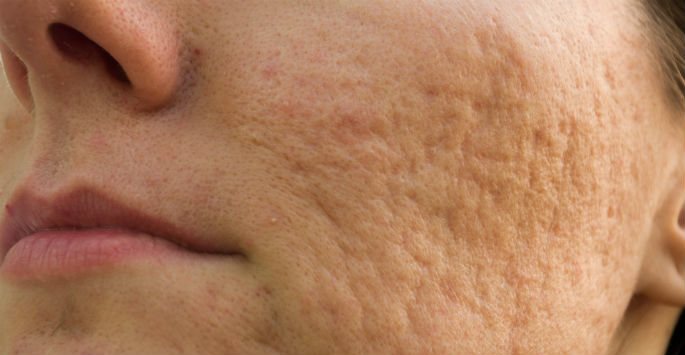Discovering Skin Conditions: Recognizing and Treating Acne Scars for Healthier Skin
Acne scars represent a significant concern for people looking for to keep healthy and balanced skin, as they can affect both appearance and self-worth. Recognizing the different types of marks, from atrophic to hypertrophic, is necessary for figuring out suitable treatment alternatives.
Recognizing Acne Scars

The body's natural recovery process can cause either atrophic scars, which appear as clinical depressions in the skin, or hypertrophic scars, which are elevated and result from overproduction of collagen. Furthermore, the emotional toll of acne marks should not be taken too lightly; several individuals report sensations of humiliation, anxiousness, and reduced self-esteem. This psychological concern can influence social communications and overall top quality of life.
Addressing acne scars needs an extensive understanding of their development and effect. Awareness of the possibility for long-lasting effects related to untreated marks can encourage people to look for appropriate treatments. Early treatment and efficient management methods can dramatically boost skin appearance and improve psychological strength, stressing the value of understanding the complexities surrounding acne scars.
Kinds Of Acne Scars
Acne marks can be classified right into unique types, each displaying distinct qualities and requiring specific therapy strategies. skin rejuvenation treatments. The key kinds of acne scars include atrophic, hypertrophic, and keloid marks

Hypertrophic scars, on the other hand, are increased over the skin level and are the result of too much collagen production during the recovery procedure. They normally remain within the limits of the initial acne lesion. Keloid scars are comparable yet extend beyond the initial injury site, developing bigger, raised locations that can be itchy or uncomfortable.
Recognizing these sorts of marks is important for picking ideal treatment choices. Various scars might respond far better to particular treatments, such as laser treatments, fillers, or surgical interventions, highlighting the relevance of a customized approach to acne scar monitoring.
Recognizing Your Marks
Acne marks typically fall right into 2 categories: hypertrophic and atrophic marks. These can even more be categorized right into ice-pick marks, boxcar scars, and rolling scars, each displaying distinctive characteristics and needing various methods for analysis.
Hypertrophic scars, on the other hand, are elevated and occur due to extreme collagen manufacturing throughout the healing process. Acknowledging the details features of your scars-- such as texture, width, and depth-- is necessary for proper identification (acne scars). Furthermore, take into consideration the distribution of marks throughout your skin, as this can show the severity and duration of the acne condition
Engaging with a skin specialist can give valuable insights into the nature of your scars, aiding in the differentiation between various kinds. A complete understanding of your marks will eventually cause a much more customized and reliable treatment strategy, making certain a more clear and healthier complexion.
Treatment Alternatives Offered
Determining the particular kind of acne marks present on your skin prepares for discovering efficient treatment options. Common types of read the full info here acne marks consist of atrophic (clinically depressed), hypertrophic (increased), and post-inflammatory erythema.
For atrophic marks, alternatives such as chemical peels, microneedling, and laser resurfacing are commonly used. Chemical peels make use of acids to get rid of the external layer of skin, promoting new cell development.
Hypertrophic marks can be treated with corticosteroid shots to squash the scar or laser treatment to minimize redness and boost appearance. Silicone gel sheets and stress dressings might also help in managing elevated scars.
In enhancement, dermal fillers can briefly load in clinical depressions from atrophic marks, while surgical excision may be appropriate for serious situations. Each therapy alternative has its factors to consider and advantages, making it vital to seek advice from with a dermatologist. They can offer tailored suggestions based upon the kind and severity of your scars, in addition to your skin kind and overall health.
Tips for Avoidance
Reliable avoidance approaches can dramatically reduce the likelihood of developing acne marks. Using non-comedogenic items aids stop clogged up pores, which can aggravate acne.
Staying clear of the impulse to select or stand out acne lesions is essential, as this can result in deeper skin damages and raise the threat of scarring. Rather, think about using a cold compress or over-the-counter treatments to lower swelling and soreness.
Sunlight security is one more essential element of prevention; ultraviolet (UV) rays can dim marks and hinder the recovery procedure. Applying a broad-spectrum sun block with at the very least SPF 30 daily can safeguard the skin and advertise also healing.
Last but not least, preserving a balanced diet regimen abundant in minerals, antioxidants, and vitamins sustains skin health and recovery. Staying hydrated and managing stress and anxiety levels can also play a substantial function in decreasing acne flare-ups. By executing these strategies, people can substantially reduce their chances of creating acne scars.
Conclusion
Finally, understanding and recognizing acne marks is vital for reliable therapy and accomplishing healthier skin. Various kinds of acne scars, consisting of hypertrophic and atrophic scars, demand details interventions customized to individual visit our website requirements. Treatment alternatives variety from chemical peels and microneedling to corticosteroid shots, highlighting the relevance of getting in touch with a skin specialist. Additionally, embracing a gentle skin care regimen and shielding the skin from UV direct exposure can significantly add to the prevention of further scarring and total skin health and wellness.
The body's natural healing process can result in either atrophic marks, which appear as depressions in the skin, or hypertrophic scars, which are raised and result from overproduction of collagen. They are further split into three subtypes: ice pick marks, boxcar marks, and rolling marks. Acne marks normally drop right into 2 groups: atrophic and hypertrophic marks. These can further be classified into ice-pick scars, boxcar scars, and rolling scars, each displaying unique qualities and needing different techniques see here now for evaluation.
Numerous kinds of acne scars, consisting of hypertrophic and atrophic marks, require certain interventions tailored to individual needs.